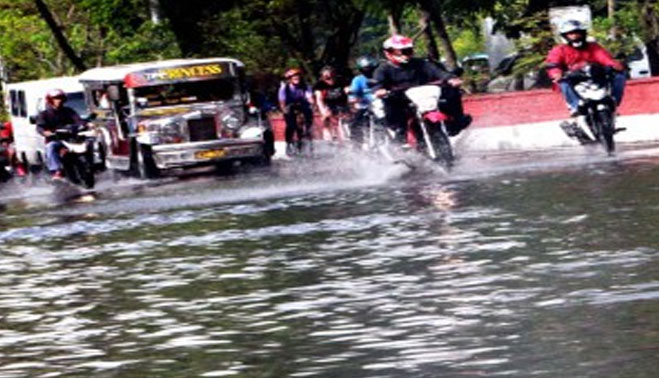![]() Home > Philippines
Home > Philippines
Rainy Season Is Here – PAGASA

Motorist experience flooded streets in Padre Burgos Manila due to heavy early Thursday morning. Forecasters are expecting seven to 17 tropical cyclones that may enter the country’s area of responsibility or form over Philippine waters from May to October.
![]() May 25th, 2016 | 09:06 AM |
May 25th, 2016 | 09:06 AM | ![]() 2110 views
2110 views
MANILA, PHILIPPINES
The rainy season is here, the Philippine Atmospheric, Geophysical and Astronomical Services Administration (PAGASA) announced on Tuesday.
Most stations belonging to Climate Type 1 areas, facing the West Philippine Sea and being directly affected by the southwest monsoon or “hanging habagat” have recorded consecutive days with rainfall, PAGASA Assistant Weather Services Chief Anthony Lucero said.
The weather stations in Type 1 climate areas are located in Laoag, Ilocos Norte; Vigan, Ilocos Norte; Dagupan, Pangasinan; Iba, Zambales; Occidental Mindoro; Metro Manila; Ambulong, Batangas; and Iloilo.
“We are estimating that in the next two to three days there will be more rains in these areas,” he said.
“There is a deep convection bringing heavy rains over the West Philippine Sea. This is a clear manifestation that rains associated with the southwest monsoon have already arrived,” he added.
Lucero also noted that the wind direction has now shifted from east to southwest.
However, he pointed out that the country is still under the El Niño episode. “We can still expect dry spell in some areas until the end of July. During or by the end of August, La Niña is expected to gradually develop but its actual impact will be felt towards the end of the year,” Lucero explained.
He said the La Niña episode may likely occur during the periods of November-January or December-February.
“We expect more rains on the eastern side of the country, which are areas more vulnerable to La Niña,” he added.
These areas are Isabela, Quirino, Quezon, Albay, Camarines Norte, Camarines Sur, Catanduanes, Sorsogon, Masbate, Samar, Leyte, Surigao del Sur, Surigao del Norte, Agusan del Norte, Agusan del Sur, Davao Oriental, and Compostela Valley.
“Most of these provinces have their peak of rainy season during December and January. Because of the La Niña, it will enhance their rainy condition,” Lucero explained.
PAGASA weather specialist Vic Manalo said Filipinos should be aware of possible scenarios following a strong El Niño event.
He compared the 2015-2016 El Niño to the 1982-1983 and 1997-1998 episodes.
“During the second half of 1982-1983 and 1997-1998 El Niño episodes, we also did not have tropical occurrences from January to June, similar to the second half of 2015-2016 El Niño where we have not seen a tropical cyclone from January to May,” Manalo said.
The absence of tropical cyclones in the first half of the year is a clear manifestation of El Niño condition, Lucero said.
“If we follow the trend of strong El Niño, the 1982-1983 and 1997-1998 El Niño events were followed by weak La Niña condition but in 1983, we have 23 tropical cyclones and in 1998 there were only 12 tropical cyclones,” Manalo pointed out.
On average, the country sees 19 to 20 tropical cyclones – a category that includes tropical depression, tropical storm, severe tropical storm, typhoon and super typhoon – every year.
Source:
courtesy of MANILA BULLETIN
by Ellalyn De Vera
If you have any stories or news that you would like to share with the global online community, please feel free to share it with us by contacting us directly at [email protected]